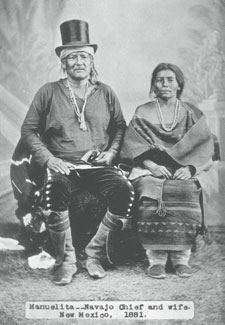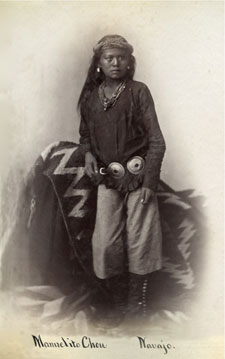Jennifer Nez Denetdale grew up in Tohatchi, N.M., a Navajo community 25 miles north of Gallup. She and her three sisters and one brother never missed school, she said, because her father insisted they become educated. “We always had books in our home. When peddlers would come by selling speed readers, vocabulary builders or encyclopedias, he bought them,” she said.
That drive to education wasn’t lost on Denetdale. She came to UNM where she studied English for her bachelor’s degree.
Lucy Tapahonso, UNM Department of English, was an early mentor for Denetdale. “She was both the first native and Navajo professor I had. The late Louis Owens was wonderful – letting me know the possibilities in the academy,” Denetdale said.
She went to Northern Arizona University for her master’s in English and doctorate in history. She taught history at UNM and NAU, then came back to UNM and is now an associate professor in American studies.
“I love the interdisciplinary nature that engages in critical studies of the United States as a nation in and beyond its borders,” she said, noting that she focuses specifically on issues of race, class and gender.
A Navajo context
Her early mentors stressed the value of storytelling in both literature and history. “Using the historical context provided through oral tradition, native scholars challenge the academy’s history of the Navajo based on documents created by non-Indians. Those come with a particular bias. We challenge the boundaries they erect,” she said.
Denetdale conducts research from the ground up, looking to the Navajo and native communities to create research questions. “Thus, native research is transforming native studies because it is about creating models of research that directly address the issues and problems we face as native nations,” she said.

Denetdale writes from the perspective of a Navajo woman “privileged with the oral traditions of the past,” she said. She added that she came to appreciate ceremonies and prayers and the knowledge and power they represent in the Navajo way.
From family history to national history
Denetdale authored, “Reclaiming Diné History: the legacies of Navajo Chief Manuelito and Juanita,” after talking about the Diné leader and his wife with her own grandparents. “As a matrilineal culture, we think about the past through mothers and grandmothers,” she said.
Denetdale recalls that at a family reunion she was asked to speak about the meaning of K’e – the relationships that shape how Navajos respond to each other and the rest of the world. In the 1990s, she interviewed her grandfather Mike Allison, who had told her stories of their great-great-great-grandmother, Juanita.
 “My grandfather wanted the younger generation to know how we’re related and shared with us the stories of Manuelito and Juanita,” she said. Among the stories was how he was a leader of those who resisted the Mexican and U.S. invasion on Navajo land.
“My grandfather wanted the younger generation to know how we’re related and shared with us the stories of Manuelito and Juanita,” she said. Among the stories was how he was a leader of those who resisted the Mexican and U.S. invasion on Navajo land.
“Based upon the stories I heard from my grandparents like Mike Allison, who died several years ago, and from American sources, I shared my insights and told my clan relatives that we all have warrior’s blood in our veins. Our grandfather Manuelito told us that land was important to our people and to protect it for future generations. He said that education isn’t just for our purposes, but to be put to use to protect land for the future,” she said.
Crossing cultures
Manuelito understood that Navajos needed to understand the ways of the non-natives and so he sent two of his sons to Carlisle Indian School in Pennsylvania in 1880s.
“His sons went with the first group of Navajos as a message to his people that education was important to Navajo people – not to become white people but to ensure the sovereignty of the Navajo Nation,” she said.
Denetdale found pictures of Manuelito’s two sons when she was invited to accompany Navajo students who took a field trip to the site of the Carlisle Indian School in Carlisle, Penn. There, she was able to spend a few days in the Cumberland Historical Society’s archives and learn about Navajo students at the Carlisle school.
“It was very emotional to see, and think of their journey across the west. Within a year, one son died there. The other was sick and came home at the request of his father. He died at home. At that point, Manuelito asked all the Navajo children to come home,” she said. By the early 1900s, others went.
Denetdale’s parents are products of Stewart Indian School, a boarding school in Carson City, Nev. Her parents speak Navajo, she said, but “we weren’t taught because of their experiences that were both traumatic and violent. They thought it would be better if we spoke English,” she said.
Through her research and conducting interviews with her grandparents, Denetdale said she improved her ability to speak Navajo. Two of her three grandchildren are learning the language, as well.
![Denetdale Works to Reclaim Navajo History [article image]](dentedale/delegation.jpg)
